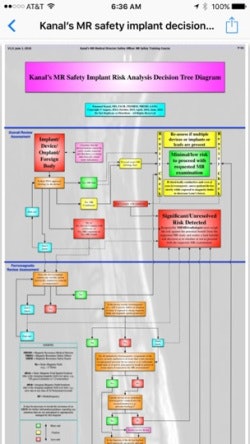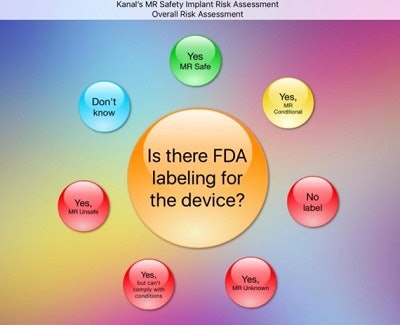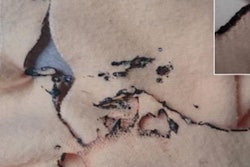
AuntMinnie.com presents the next article in an ongoing series highlighting notable mobile apps in radiology. In this installment, we take a look at Kanal's MR Safety Implant Risk Assessment (MRSIRA), a new iOS app designed by longtime MRI safety advocate Dr. Emanuel Kanal.
Kanal, who is director of MR services at the University of Pittsburgh Medical Center, developed the app as an adjunct for attendees of his MR safety training courses. It aims to help users with the challenging task of assessing the level of risk faced by patients with metallic devices or foreign bodies in undergoing MRI exams. We chatted recently with Kanal to learn more about the app.
AuntMinnie: What inspired you to create this app? What problem does it help solve?
Kanal: Adverse events in the MR environment -- the vast majority of which are completely avoidable and preventable -- continue to occur at an unacceptable rate, even though MRI technology has now been used for over three decades.
 Dr. Emanuel Kanal, director of MR services at University of Pittsburgh Medical Center.
Dr. Emanuel Kanal, director of MR services at University of Pittsburgh Medical Center.The modality uses exceptionally strong magnetic fields (that are static or not changing over time), radio waves (actually, radiofrequency oscillating magnetic fields that change at millions of times per second and themselves are pulsed at hundreds of times per second), and gradient magnetic fields that are pulsed at thousands of times per second. Furthermore, what parts of the human body may be exposed to what energies at what points in time are not at all obvious to the extreme majority of healthcare providers, even to MR workers who have quite literally been working in the field for decades.
Various metallic implants or foreign bodies or devices that may be on or in a patient can interact with these magnetic energies during an MR imaging examination. Metals can interact with these magnetic fields in a way that poses a potential hazard to the patient and/or others near them. Furthermore, not all metals interact in the same fashion when exposed to these different types of magnetic fields!
Therefore, it may be difficult for the uninitiated to determine whether it is actually safe or not to expose a patient to the MR imaging environment if that patient has a metallic foreign body, implant, or device. It may not at all be obvious as to whether or not a patient with such a device or foreign body can safely undergo a requested MRI examination.
Further, the same patient may be able to quite safely undergo one type of MRI study of a specific part of their anatomy, but not the same or another type of MRI study on another part of their body! To make matters worse, what may be "safe" or acceptable on some MR imaging systems may not be safe on others of different strengths, configurations, or designs.
To date, we have experienced the worst of both worlds. Some patients may have historically been denied access to requested and clinically indicated MRI studies in the name of "safety." This is quite ironic, since it is quite possible that instead of being granted access to an MRI study that might have been safely performed, the patient's requested MRI study may have been canceled and the patient may have instead been sent to undergo a different diagnostic imaging examination such as angiography or myelography, which may be more invasive and/or may be associated with a higher significant complications rate/risk. Alternatively, other such patients may have been inappropriately granted access to MRI studies with, at times, suboptimal or even disastrous results.
 The app is designed to serve as an animated embodiment of Kanal's MR safety decision-tree diagram. All images courtesy of Dr. Emanuel Kanal.
The app is designed to serve as an animated embodiment of Kanal's MR safety decision-tree diagram. All images courtesy of Dr. Emanuel Kanal.Recognizing this relative deficiency in the knowledge of background underlying physics and safety by MRI users worldwide motivated me to develop this app, which was created to serve two distinct purposes:
- To assist the end user in understanding the underlying potential safety concerns of exposure of a patient with an implanted device or foreign body to the unique MR imaging environment and the energies utilized in the MR imaging process.
- To help guide the user as they attempt to navigate the process of assessing and quantifying the relative risks of permitting a patient with an implanted device or foreign body to undergo a specifically requested MR imaging examination(s) on a specific part(s) of their anatomy on a specific type of MR imaging system.
This app is therefore intended as a teaching tool only to illustrate a decision-tree methodology and a reasoning approach that I utilize in my clinical decision-making process in assessing the relative risks and safety of exposing patients with various implants/devices/foreign bodies to a requested MRI examination and/or physical MRI environments. It considers and highlights the various energies and potential risks associated with the MR imaging process, and graphically and efficiently guides the user to being able to quantify the relative risk of permitting a patient to undergo a specific requested MR imaging examination.
Who is the target audience, and how do you envision the app will be used? Could it also be used by those who haven't attended one of your MR safety training courses?
The app is intended primarily for MR technologists, radiologists, or MR physicists as they attempt to perform a risk analysis for patients who may require an MR imaging examination. While it can be used broadly by anyone, it is ideally intended for those who have a solid working knowledge of the types of magnetic fields and energies behind the MR imaging process -- something taught in significant detail in my courses.
What are the app's most important features?
As a licensed instrument pilot, I have been impressed with the degree of safety that has been achieved in flight in both commercial and even general aviation. Despite obvious and quite significant potential hazards, aviation safety in the U.S. has been raised to a level that far surpasses most other relatively safe but potentially hazardous activities in which humans are routinely involved, such as driving.
One of the implemented methodologies that has helped to so dramatically improve our collective aviation safety performance has been the almost religious insistence on utilizing checklists in all aspects of executing our duties as pilots in command. In a similar fashion -- even for those with a working knowledge of the various energies used in the MR imaging process -- it can be a relatively daunting task to try to juggle consideration of each and all of them when trying to assess whether it may be safe to permit a given patient to undergo a requested MR imaging examination.
This app is designed in such a way that it forces the end user to consider all potential safety considerations regarding possible harmful interactions between the MR imaging environment and the patient's implant, device, or foreign body, and it will not permit the user of the app to arrive at a conclusive risk assessment until all safety considerations for each type of energy used are considered, individually assessed, and relatively quantified.
For example, among the various risk factors to be considered in the app are the characteristics of the device/implant, the type of magnet, the type of study to be performed, the location of the implant/device in the patient relative to where in the MR scan room the various potentially harmful energies may be found, the energies to be transmitted in the MR imaging process and their locations and magnitudes relative to the positioning in the patient, etc. In this fashion, it pursues assessment of all MR-related safety considerations before a conclusion can be reached, and, as with any checklist, almost forces the user to consider all possible harmful interactions before a risk assessment conclusion is provided.
 App users are guided methodically through an assessment of all MR safety-related considerations.
App users are guided methodically through an assessment of all MR safety-related considerations.The app also has the unique ability to leave a written trail highlighting the answer to every question asked about the patient/device to document precisely how every risk was assessed and managed. It can provide a written record that can be output as a PDF file as written documentation of the thought processes that were considered and managed in the risk-assessment process for any given real or theoretical patient or situation, which can prove helpful whether one is teaching or attempting to document something for a patient's electronic health record.
Further, as educators, we could utilize the app to create a virtually infinite number of real or theoretical patient cases and review how the answers to the questions provided in each case may lead to impressively different conclusions and recommendations for the same patient based on seemingly minor considerations, such as the location of the device in the patient and the field strength of the MR imaging unit to be used. This could thereby assist educators in creating an entire curriculum of potential clinical or research scenarios for students of MR safety.
Finally, the app is designed to provide some level of quantification of relative risk for a patient with an implanted device or foreign body who might undergo a requested MR imaging examination, or a healthcare worker who may want or need to be exposed to the MR imaging environment. It does not in any way assess the potential benefit of so doing. Thus, it can also be utilized to teach and demonstrate how a given level of assessed risk can prove to be acceptable in one circumstance or entirely unacceptable in others, depending on, for example, whether the requested MR exposure was for employment, research, or elective versus urgent versus emergent clinical needs.
What are your future plans for the app? Are there any new features or content in the works?
Plans are underway for expansion and further development of the app to implement greater teaching capabilities as well as faster and more efficient ways of visualizing and interacting with the processes described above.
Do you plan to develop a version for Android?
There are no plans in the immediate future to develop an Android version of the app.
Kanal's MR Safety Implant Risk Assessment can be downloaded for $99.99 from the iTunes Store and was programmed by mobile app developer iCat Solutions.




















